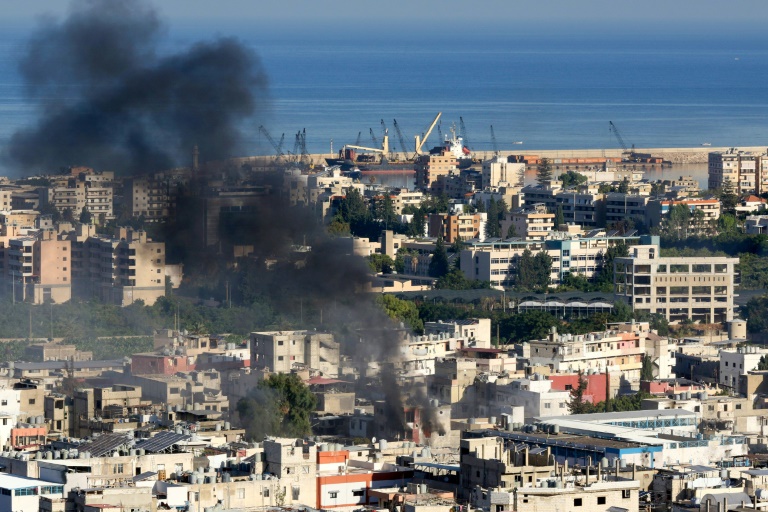Ain al-Helweh Palestinian camp: island of misery in south Lebanon

Smoke billows during clashes in the Palestinian refugee camp of Ain al-Helweh, in Lebanon’s southern city of Sidon
Beirut – An outbreak of violence this week rocked the densely populated, walled-off Palestinian refugee camp of Ain al-Helweh on the outskirts of the southern Lebanese city of Sidon.
Over the years, Islamist militants have established a presence in the impoverished camp, home to tens of thousands of people, and its isolation has also made Ain al-Helweh a haven for those seeking to evade the Lebanese authorities.
The latest clashes which erupted late Thursday once again pitted Islamists against members of Palestinian president Mahmud Abbas’s Fatah movement, and left nearly two dozen wounded.
– Largest camp –
Ain al-Helweh is the largest of Lebanon’s 12 Palestinian refugee camps, now bustling urban districts.
Its estimated 54,000 residents have been joined in recent years by some 6,000 Palestinians who sought refuge from Syria’s civil war, all crammed in an area covering no more than two square kilometres (0.8 square miles).
The camp, with its narrow alleyways, is surrounded by a wall erected by the Lebanese army, whose forces control all four entrances.
A 1969 agreement between Beirut and the Palestine Liberation Organization (PLO) stipulated that security in Ain al-Helweh and the other refugee camps was to be handled by Palestinian factions rather than Lebanese forces.
The Lebanese government annulled the deal in 1987, but the army still does not enter Palestinian camps by long-standing convention.
– Factions –
Fatah, which controls the PLO and the Palestinian Authority, remains the most influential actor in Ain al-Helweh, though rival factions like Hamas and Islamic Jihad threaten its hegemony.
Parts of the camp have also become bastions of Islamist cells of Lebanese and Syrian nationals, which include some fugitives.
One of the better known of them is Lebanese-Palestinian singer Fadel Shaker, who had been sentenced to 15 years in prison for supporting local Sunni extremist groups.
– Poverty –
According to UNRWA, the United Nations’ agency for Palestinian refugees, more than 80 percent of Palestinian refugees in Lebanon live in poverty.
The UN agency operates eight schools and two clinics in Ain al-Helweh.
Over 480,000 Palestinians are registered with UNRWA in Lebanon, but the number of those still in the country is currently estimated at 250,000.
Many have emigrated since Lebanon’s crippling economic crisis that began in 2019 and has had a devastating impact on Palestinians, who face a variety of legal restrictions including on employment.
Lebanese authorities bar Palestinians from dozens of professions.
– ‘Capital of the diaspora’ –
Ain al-Helweh and other refugee camps were created for Palestinians who were driven out or fled during the 1948 war that coincided with Israel’s creation.
Some areas of the camp carry the names of the towns and villages its residents had left behind, and Palestinians dub Ain al-Helweh “the capital of the diaspora”.
Refugees initially lived in tents in dire conditions, but gradually began building permanent houses — despite a ban from Lebanese authorities, according to Palestinian analyst Souheil Natour.
When Israel invaded Lebanon in 1982, Ain al-Helweh was “practically razed by Israeli troops and hundreds of its men were arrested”, Natour said.
Residents later reconstructed their homes, and the Israeli army withdrew from the Sidon area in 1985.
